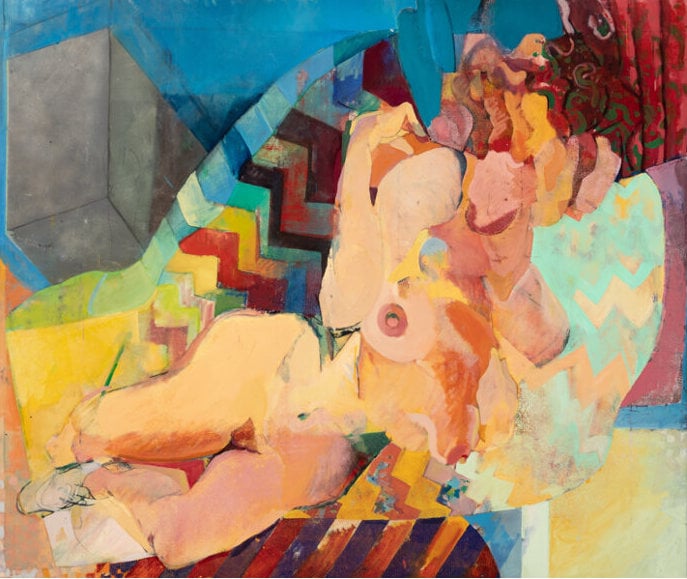
A former dog walker living on Social Security benefits in Upper Manhattan, Mark Herman thought he had struck it rich when he was gifted an early canvas by Chuck Close, one of the innovators of late 20th-century art. His dreams were reinforced during a psychedelic experience with magic mushrooms, when he became convinced the painting would sell for $10 million. Despite these high hopes, in the end, the piece sold for the more modest sum of $50,000, including buyer’s fees, at a November 14 sale at Heritage Auction House.
Herman received the painting in 2022 when his sole client, an ex-law professor named Isidore Silver, gave it to him, knowing it to be a lost work by painter Close. The brightly hued painting, Untitled (Danaë) (1965–66), shows a reclining female nude.
“I see it as a transitional piece tying together Chuck Close’s early work to his 1970s photorealism,” Taylor Curry, director of Modern and contemporary art at Heritage New York, said in a phone interview.
Close, who was an instructor at the University of Massachusetts Amherst when he painted the work, was not yet known for his photorealist portraits, and was painting in a more abstract style informed by Willem de Kooning. These paintings were marked as much by their edgy titles as by their expressionist brushwork. Some referenced child sexuality, according to the New York Times, for example I’m only 12 and already my mother’s lover wants me and I am the only virgin in my school.
Silver represented Close in a free speech case against the school when it closed an exhibition of the works after just five days and removed the paintings from display, winning in court but losing on appeal. The paintings, per the Times, vanished into obscurity.
In Curry’s mind, the experience in Massachusetts may well have driven Close’s move to New York. “If he had a successful exhibition, he probably would have stayed. He upset a lot of people and I think that’s one of the reasons he came to New York,” the auctioneer said. “Otherwise, who knows what we would have seen from him?”
Chuck Close at the 2016 MoMA Party in the Garden Benefit at the Museum of Modern Art, New York Ciity. Photo by Liam McMullan ©Patrick McMullan.
Herman would later become Silver’s dog walker, and when the two hit it off, Silver gave Herman the canvas along with a 17-year-old toy poodle.
The gift seemed like a windfall when Herman looked into Close’s previous market success, since the artist showed at Pace Gallery and his paintings sold for millions at auction. But Pace, according to the Times, would require $5,000 to stretch and evaluate the painting—money Herman did not have. Sotheby’s, meanwhile, agreed to offer the canvas at auction in December 2022 with a high estimate of $20,000. Because it was an early, abstract work and because Close’s market was affected by accusations of sexual harassment, the auction house did not predict it would reach the highs of some of his more recognizable works, much less the price promised by the psychedelic mushrooms.
But things got more complicated when Sotheby’s reached out to Pace, and Pace in turn contacted the artist’s studio, and it was revealed that neither had records of the work, meaning it could not be authenticated. Sotheby’s revoked the offer of sale, and in fact billed Herman $1,742 for stretching the canvas.
“It was a smack to the face,” Herman said, speaking to Artnet News by phone. “I knew the painting was real, and I’m sure they did too, but I just think they didn’t want to get involved. They didn’t want anything to do with ‘nude’ and Chuck Close in the same sentence.”
With the studio failing to confirm the work’s authenticity, Herman made the rounds of organizations like the Museum of Modern Art, the Whitney Museum of American Art, and the International Foundation for Art Research, but they either were not interested or required payment and documentation in order to investigate the work, which were beyond Herman’s means. The University had no record of the 1967 exhibition, Herman said.
In a stroke of luck, an archivist at the University of Massachusetts unearthed some data on the original exhibition, including a copy of the Massachusetts Collegian that included the article “Art Exhibit Closed by UMass Officials,” complete with photos of the painting in question. Sotheby’s was unswayed, but for Herman, “It was like looking at a winning lottery ticket.”
Heritage came to the rescue, estimating the painting to sell at $20,000 to $30,000. An early bid even came in at $40,000, according to the Times, but bidding stalled there, and after two minutes, the auctioneer’s hammer dropped. The painting went to lawyer James Pincow and his father, Robert, for $50,000, including the house’s fees.
“I’m happy with what I got,” Herman stoically said over the phone. “It rose to about its level. If it garnered a lot more it would have been an outlier.”
More Trending Stories:
Conservators Find a ‘Monstrous Figure’ Hidden in an 18th-Century Joshua Reynolds Painting
A First-Class Dinner Menu Salvaged From the Titanic Makes Waves at Auction
The Louvre Seeks Donations to Stop an American Museum From Acquiring a French Masterpiece
Meet the Woman Behind ‘Weird Medieval Guys,’ the Internet Hit Mining Odd Art From the Middle Ages
A Golden Rothko Shines at Christie’s as Passion for Abstract Expressionism Endures
Agnes Martin Is the Quiet Star of the New York Sales. Here’s Why $18.7 Million Is Still a Bargain
Mega Collector Joseph Lau Shoots Down Rumors That His Wife Lost Him Billions in Bad Investments